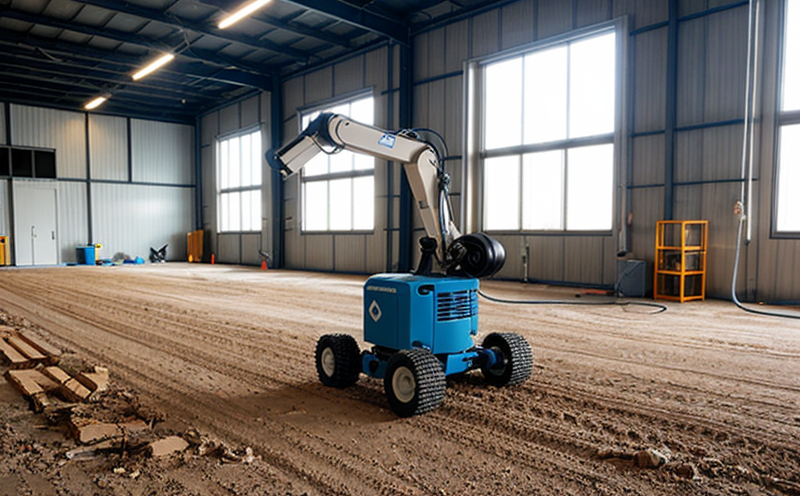IEC 60068-2-64 Random Vibration Durability Testing of Robots
The IEC 60068-2-64 standard specifies the method for random vibration testing to evaluate the durability and structural integrity of electronic components, electromechanical devices, and systems. This test is particularly critical in industries where reliability under dynamic environments is paramount, such as robotics and artificial intelligence (AI) systems.
Robots used in various sectors—automotive manufacturing, medical equipment, space exploration, and construction—often encounter harsh environmental conditions that can lead to mechanical failures if not properly tested. Random vibration testing helps ensure these robots can withstand the stresses of real-world usage without compromising performance or safety.
The random vibration test simulates the unpredictable forces that a robot might experience during operation in different environments. This includes vibrations from moving parts, ground irregularities, and other dynamic factors. By subjecting the robotic system to controlled random vibrations within specified frequency ranges and amplitudes, engineers can identify potential weaknesses or design flaws before deployment.
The testing process involves several critical steps:
- Specimen preparation: Ensuring all components are securely fastened and wired correctly.
- Vibration setup: Configuring the test equipment to deliver vibrations within the required frequency range and amplitude.
- Data collection: Monitoring the robot’s response using advanced sensors and data acquisition systems.
- Analysis: Evaluating the collected data to determine if the robot meets specified durability criteria.
The standard defines acceptance criteria based on observable characteristics such as component failure, structural deformation, or functional degradation. Compliance with these criteria ensures that the tested robotic system can operate reliably under expected environmental conditions.
Real-world applications of this test include:
- Evaluating the robustness of robotic arms in industrial manufacturing lines subjected to frequent mechanical shocks.
- Ensuring the safety and longevity of surgical robots used in delicate operations.
- Testing space exploration robots that must function reliably in environments with significant vibration.
The IEC 60068-2-64 standard is widely recognized for its rigorous approach to assessing durability under random vibrations. This ensures that industries can trust the results, leading to increased confidence in the reliability of robotic systems across various applications.
Applied Standards
| Standard Name | Description |
|---|---|
| IEC 60068-2-64 | This standard specifies the method for random vibration testing to evaluate the durability and structural integrity of electronic components, electromechanical devices, and systems. |
| ISO 10859 | Describes the general requirements for environmental testing laboratories. |
| ASTM E2673 | Details the procedure for evaluating the durability of electronic components under random vibration conditions. |
The IEC 60068-2-64 standard is complemented by other international standards that ensure comprehensive environmental testing. ISO 10859 provides general requirements for environmental testing laboratories, while ASTM E2673 focuses on evaluating the durability of electronic components under random vibration conditions.
Scope and Methodology
The scope of IEC 60068-2-64 random vibration testing includes:
- Evaluating the structural integrity and performance of robotic systems subjected to random vibrations.
- Determining compliance with specified durability criteria for various environmental conditions.
- Identifying potential weaknesses or design flaws in robotic components before deployment.
The methodology involves:
- Specimen preparation: Ensuring all components are securely fastened and wired correctly.
- Vibration setup: Configuring the test equipment to deliver vibrations within the required frequency range and amplitude.
- Data collection: Monitoring the robot’s response using advanced sensors and data acquisition systems.
- Analysis: Evaluating the collected data to determine if the robot meets specified durability criteria.
The testing process is conducted in a controlled environment that simulates real-world conditions. This includes setting up the test rig with the robotic system, applying random vibrations according to the specified parameters, and monitoring the system’s response throughout the test duration.
Compliance with IEC 60068-2-64 requires the tested robotic systems to meet specific acceptance criteria based on observable characteristics such as component failure, structural deformation, or functional degradation. These criteria ensure that the tested robotic systems can operate reliably under expected environmental conditions.
International Acceptance and Recognition
The IEC 60068-2-64 standard is widely recognized for its rigorous approach to assessing durability under random vibrations. This ensures that industries can trust the results, leading to increased confidence in the reliability of robotic systems across various applications.
Many companies and organizations around the world have adopted this standard due to its comprehensive testing methodology. Organizations like the International Electrotechnical Commission (IEC), National Electrical Manufacturers Association (NEMA), and Society of Automotive Engineers (SAE) endorse the use of IEC 60068-2-64 for evaluating robotic systems.
The acceptance of this standard is evident in its widespread application across industries, including automotive manufacturing, medical equipment, space exploration, and construction. By ensuring compliance with these standards, companies can demonstrate their commitment to quality and reliability, enhancing trust among customers and stakeholders.





